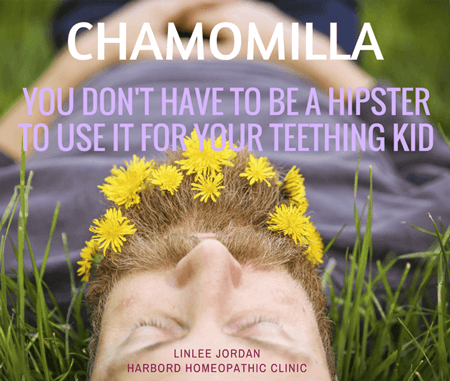Chamomilla for teething is part of the the homeopathic first aid kit around the world. Seeing a dose or two of the homeopathic remedy Chamomilla change a fractious child into a calm child is something not soon forgotten. Teething symptoms fade and the pain lessens in such a smooth and simple way that Chamomilla for teething has earned a reputation worldwide. It is used successfully so often by parents and homeopaths that we can all be forgiven for thinking of it as a specific remedy for teething. Yet sometimes there are other teething remedies that may be more suitable. Parents can get the best out of using homeopathy at home by carefully choosing a teething remedy according to an individual cluster of symptoms.
There are some questions that parents may ask: when is the popular Chamomilla going to be the most appropriate remedy and before explaining that, what is homeopathy? And what exactly is teething anyway?
What is homeopathy?
Homeopathy is a form of holistic medicine, which is different from modern medicine because it works on the whole entanglement of symptoms and on the susceptibility to teething problems. It does this by stimulating the body’s innate healing ability.
As a medicine, homeopathy has stood the test of time. The remedies used in modern homeopathic practice have survived for centuries without change in the way they are used or made. The use of Chamomilla for teething first started 200 years ago.
What is a remedy?
A homeopathic medicine is called a remedy. Remedies are made in homeopathic pharmacies from a vast assortment of substances including herbs and minerals. The homeopathic remedy Chamomilla is made from the herb Chamomile that has been used as a herb tea since the 1st century AD. Turning the herb into a remedy makes it capable of treating the emotional, mental and physical symptoms of teething. Some remedies like Chamomilla are used so often in the home situation that parents keep them in a first aid kit to use for immediate problems, especially in the middle of the night. Other remedies, such as Saccharum, are available only after consult with a professional homeopath. Homeopathic remedies can be used alongside basic practical measures to ease teething symptoms and bring the baby back to balance.
Another way that remedies are available is in homeopathic teething formulas that can be purchased from health food shops and pharmacies. They contain a collection of the first aid remedies and always contain Chamomilla for teething. These formulas can be very effective and serve as a wonderful introduction to using remedies. They are designed for blanket coverage of teething problems and give temporary relief from the pain, discomfort and irritability caused by teething. When a formula is sold over the counter of course it is not intended to have the same impact as an individually chosen remedy. Carefully choosing one remedy is not a temporary solution and gives more lasting results. It also allows the opportunity to learn about the remedies as separate entities and is worth the effort in the long term.
What is teething?
Throughout history there have been references to teething causing a wide variety of childhood symptoms. Teething difficulties are mentioned as early as 1200BC in the Homeric hymns and also in 1000BC in the prayers of early Indian literature. Eighteenth and nineteenth century treatments for teething were varied and included doses of mercury salts, leeches, opium, lancing of the gums, purgatives and emetics. In 1839, there were 5016 deaths in England and Wales attributed to teething. With our modern understanding of health we can see it is likely that the babies may have died from dehydration and other problems associated with the harsh treatment of the times.
Mrs. Winslow’s Soothing Syrup, first marketed in 1849, was an extremely popular teething mixture, which contained a generous level of alcohol and morphine sulfate and could cause coma, addiction or death from overdose. It was removed from the market in the 1930’s. Understandably there was a widespread fear of the role of teething in childhood illness which has disappeared with increasing knowledge of medicine and diseases.
Modern medical opinion varies about what teething entails, with some research finding that teething itself rarely causes symptoms. Bearing that in mind it is in the nature of homeopathy that it is treating the whole child so it will be working on their teeth pain at the same time as their other individual symptoms regardless of whether “teething” exists. However parents, grandmothers and nurses clearly associate teething with symptoms which is borne out by several studies. Other recent research has connected the possibility of the presence of the herpes virus with teething symptoms.
Nowadays teething is the term popularly used to explain lots of problems in babies up to about two and a half years old. Homeopaths believe that some babies find the experience painful and others go through it without an ordeal because each has a different susceptibility to teething problems. Any restless baby with red cheeks, a runny nose, lots of saliva, looseness of bowels, irritability and sleeplessness might be said to be suffering from teething. There is not one typical symptom cluster, which reliably predicts the imminent arrival of a tooth.
There are babies who will have some of these symptoms every time they are teething without going on to produce an illness. However these symptoms can be part of the first stage of some health problems. Consequently, if your baby develops a fever, vomiting, convulsions, diarrhoea or loss of appetite it’s wise to get a health professional to check them.
When is Chamomilla for teething, the right choice of remedy?
The individual way that a baby reacts during teething is the key to knowing which remedy to use. Most important is the way they want to be held, for example a baby who needs Chamomilla demands to be held while being carried around and will cry angrily, hit and kick if put down. If they are reacting in this way and the following symptoms are present then Chamomilla is the best choice of remedy:
- They quieten when the parents walk up and down but even after a while of walking and being held the baby may still start to cry with the parents getting worn out
- The baby demands food, toys and drinks but when offered them will throw them across the room.
- They seem to be abnormally sensitive to pain and don’t like being looked at.
- During sleep they toss and turn and cry out loud and generally cry more at night especially around 9pm to 10pm.
- Their gums are sore so they keep their mouth open. They will dribble and keep their fingers in their mouth. While in this state they are prone to having loose greenish stools and their face is flushed on one side

Cina compared with Chamomilla for teething
Cina is one of the remedies which most resembles Chamomilla because the baby needing Cina is also irritable, capricious and wants to be held. However, the Cina baby will seem to want to be picked up, but when you do it they are still unhappy. Trying to caress or hug them will make them stiffen their body or throw their head backwards so that you almost drop them. Despite the best efforts quietening them seems out of the question. You can’t seem to do anything to please them, whereas the Chamomilla child will at least settle for a while when carried. They may have loose stools but not greenish as in Chamomilla. They may look paler during teething than they normally do.
Arsenicum
The baby needing Arsenicum will also want to be carried, the difference is that they like being walked around briskly and will quieten down when you do it. Arsenicum babies are the ones whose parents soon figure out that a ride in the car at 1am may be the only thing that will put them back to sleep. They can be angry just like Chamomilla and Cina but are worse in the middle of the night between midnight and 2am. The baby who needs Arsenicum may have a loose stool, which is burning and gives them nappy rash. If they have a runny nose it will burn the skin around their nose.
Mag phos
If the symptoms are all jumbled together and you are not sure whether your baby has colic or is teething, the remedy needed is Mag phos. The crampy type of tummy pain will make them draw their legs up and the parent will discover that the pains are greatly relieved by the warmth of a hand and the firm pressure of rubbing their belly. Arsenicum babies also like warmth but you can differentiate between the two remedies because Arsenicum is restless and Mag phos will seem too tired and exhausted to move other than to raise their legs up. The Mag phos baby may also have cracks in the corners of their mouth.
Mercurius
A baby who needs Mercurius is sweaty, smelly and very thirsty even though their mouth is moist. There will be redness of the gums, a constant inclination to swallow, flabby tongue, ulcers in the mouth, bad breath and such copious drooling of saliva that there will be a pool of saliva on the pillow. During teething they will be anxious, hurried, restless and have trouble sitting still. Becoming both easily chilled and easily overheated is a characteristic of Mercurius.
Nux vomica
Nux vomica will help a baby who is irritable, stroppy, quarrelsome and oversensitive mentally and physically to open air, cold air, drafts, being strapped into their car seat, tight elastic on pants, noise, smell and music. Some of them will even raise an objection if the adults are having a conversation, it seems to be too much noise for them and they certainly will object to having the radio on in the car. Because they are impatient, head strong and self willed they are babies who really seem to know what they want and they want it right now. They get the hiccoughs and burps during teething. An uninterrupted nap will do them the world of good if they could only stay asleep long enough. If your baby is one of those little ones who wakes too early then can’t go back to sleep again, coupled with a hypersensitivity then they will be sure to respond to Nux vomica.
Pulsatilla compared with Chamomilla for teething
The remedies Pulsatilla and Chamomilla are very different because a child needing Pulsatilla is gentler, and will weep and whine easily rather than screaming and will want to be carried slowly and gently. Changing, shifting symptoms and moods from one minute to the next will confuse the parents. They want sympathy and attention and become clingy and weepy. After a cry they will seem to freshen up and be in a better mood. If they have a runny nose it will be bland, thick, a dirty yellow or green and it will not burn the skin. The time of day when they are at their worst is in the afternoon between 3pm and 5pm. They love to be carried outside in the fresh air. The Pulsatilla baby is not very thirsty even though their mouth and lips are dry. They may have a bloated tummy and their stool will be changeable.
All the previous remedies can be given by parents at home and will be found in homeopathic first aid kits. As well as these, there are several indispensable teething remedies, which would be prescribed only after a consult with a professional homeopath. Examples of these other teething remedies are as follows.
Calc carb
These babies get their teeth later than the average and then have much difficulty with them coming through. These babies gain weight easily and are normally contented however while cutting teeth they can be very stubborn. Calc carb babies will quieten quickly when picked up. Parents will notice that they seem to be happier to just sit in their pram than to have their feet on the ground. They sweat easily on their head especially during sleep. Old textbooks of homeopathy say that one third of children require this remedy however modern day homeopaths have noticed that the need for the remedy is decreasing.
Kali carb
These babies also want to be carried and love to be rocked. They really feel better when you carry them with their tummy over your shoulder. Their teething troubles are worse from 2am to 4am. Their face looks puffy and they seem to be weakened by the teething. The Kali carb baby tends to be jumpy and startles easily by unexpected touch or noise, more so than other babies.
Saccharum
Like Kali carb, the babies who need Saccharum love to be rocked. After sweets they are a handful and kick and hit. They demand food immediately on waking and the transformation after getting some food in their mouth is remarkable. Their face looks pale like Cina. Pushing away will be their first response when the parent tries to carry them but if the parent persists they will give in to the cuddle or the rocking which is what they actually really wanted. Saccharum is a remedy needed more and more by children in modern homeopathy.
Thirteen tips about teething and when using Chamomilla for teething will be effective
- Parents naturally hesitate before giving their baby any treatment, but can feel reassured to know that the exceedingly small doses used in homeopathic medicine make them safe.
- A remedy can be given as a dose of two pills or five drops in a strength of 30c once every four hours. If you have given more than six doses and it hasn’t helped then try a different remedy.
- A blissful and common response to a well chosen remedy is having a child being finally able to give in to their sleepiness and have a nap.
- If dribble is causing a rash try using paw paw ointment on the chin as a barrier.
- Massage your baby’s gums with your finger. Some enjoy the pressure in the same way they like to chew on things. Once they are old enough for chewing chunky food you can try letting them gnaw on celery sticks, raw apple rings and dried bananas. The bananas taste great but make such a mess that you will probably decide to use them just before it’s time for a bath or even while sitting in the bath.
- If you can’t avoid going out when it is cold and windy use scarves and beanies.
- Both parents of a teething baby need time out. Ask for help.
- After using a teething formula or different individual remedies at home and they haven’t helped, consult a professional homeopath. Your baby may need one of the less common remedies that are not for home use.
- If you have a friend who says that they have gone through bottles of Chamomilla for teething, chances are they are overusing the remedy. Remind them that it is still a medicine. No matter how gentle homeopathy is, there are still cautions which apply.
- Don’t use chamomile tea at the same time as using Chamomilla or a teething formula. It is giving a double dose. In homeopathy less is better. If you find your baby responds to chamomile tea then just use the tea, there is no need to use a remedy as well.
- Local anaesthetic gel may be washed away too quickly by saliva.
- Any child with recurring teething problems will benefit from having a check up with a chiropractor or an osteopath.
- You don’t have to be a hipster to use Chamomilla for teething 🙂
By taking the time to understand more about homeopathy you can use Chamomilla for teething and the other remedies in the most effective way possible. Homeopathic first aid courses will explain all these points in more detail. To find a course phone your local community college, college of natural therapies or ask your local homeopath to run a course. To find a local, professional homeopath phone the Australian Homeopathic Association in your state or see www.homeopathyoz.org First aid remedies and kits may be available from health food shops, our Australian homeopathic pharmacies, and professional homeopaths.
When to use Chamomilla for teething and when not to? was first published in WellBeing Magazine “Treating the Torment of Teething with Homeopathy” 2004 #98 page 32 -35
- Filling in the Gaps: A Homeopath’s Tour of a Dental Technician Lab - 08/11/2024
- Homeopathy surge worldwide - 11/08/2024
- Autism is helped by several different styles of homeopathy - 07/05/2024




Leave a Reply